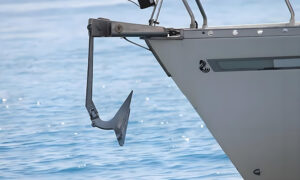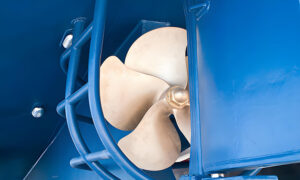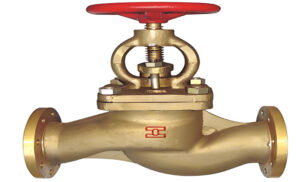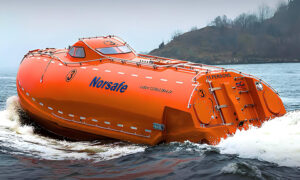Irrespective of which container lashing bar manufactory you prefer, we will explain in detail all you need to know about container lashing bars, from the full description of container lashing bars, and types of container lashing bars, down to popular stores that market container lashing bars and supportive equipment, in a bid to help you choose the best container lashing bar. Let’s dive in!
In overview, container lashing is the process of safely securing shipping containers on the cargo ship. Here, the shipping containers are loaded onto the cargo ship, then they’re secured together with the containers below them and into the ship’s structure itself.
Overview of Container Lashing Bar
Lashing bars are used jointly with turnbuckles to tension the container lashings of a container ship. The swivel head of a lashing bar is made to match the hole of a container corner casting. The other end is attached to the right turnbuckle. Diverse lengths of lashing bars are available in online stores if you need them.
Full description of Lashing Bars
Here we have small lashing bars as well as much longer lashing bars so you see that figure one is a lashing bar that is utilized for a second-tier container and so those are the shorter lashing bars and then figure two that you can picture a much longer lashing bar. Although the second figure may confuse you, when you look at it, note that it’s not two separate bars it’s actually a single bar.
It’s just trying to show you the length and how much lengthier it is with respect to the shorter lashing bar. The longer lashing bar is utilized to lash the third high container.
However, when we say third high that would mean if there are three containers it is used to lash the third container from the bottom, and the shorter lashing bars are utilized to latch the second container from the bottom.
Furthermore, we will show you pictures of how it all looks and what happens with the bottommost container, because on container ships you can only lash three containers and the rest of the containers are pretty much reliant on the twist lock system
This is the perfect picture of a lashing bar.
You can see how one end of the lashing bar goes into the slot of the container while the other end of the lashing bar is tied to a turnbuckle to the ship structure.
That is how it binds the lashing together. You can also see a kind of hook protruding from under the container that is the hook of a twist lock. It works as a locking mechanism of a twist lock.
These are how the lashing bars are reserved. Most of these lashing bars are kept near every hatch cover where the containers are loaded on the deck.
If they are not in use, they are kept close to the hatch cover because it is easier for the stevedores. It helps them to just use it from a place that is closer to the hatch cover. Then when it is not in use they are put back into the slots.
The lashing bars you see in the image above are not the shorter lashing bars these are the longer lashing bars that are used to lash the third high container. If you go towards the extreme end of the image, you can see there are some turn buckles there.
This is the perfect image of a turnbuckle bar.
As one end goes into the lashing bar, the other end is shackled onto the ship structure. That’s how a container is linked to the ship structure, and that is how the container lashing mechanism works when it comes to lashing bars and turnbuckles.
Container Lashing Bar / Lashing Rods
Here are some key points to note about container lashing bars and lashing rods below.
- Lashing bars are employed on the ends of the containers while aboard the ship to secure the container stacks to the ship.
- Short bars of about 2,500 mm go to the footing of the 2nd container tier.
- Long bars of about 4,500 to 5,000 mm go to the footing of the 3rd container tier.
- The bars have a swivel head on one end that can fit into the end of the container corner casting.
- The other end is to be used in conjunction with the right turnbuckle which in turn is secured to a d ring or lashing plate which is welded to the ship’s deck
Types of Lashing Bars
Container lashing bars have three types: vertical type, knob type, and swivelhead type.
The knob lashing bar is typically used with a knob turnbuckle, while the eye/swivelhead lashing bar is commonly used with a jaw/hook turnbuckle.
However, all of them are used to fix the container on the shipping deck through connecting the turnbuckle, extension rod, and eye plates together. It is made of high-tension steel with hot dip galvanizing on the exterior.
Other Supportive Container Lashing Equipment
The process of container lashing involves the usage of different equipment, including components like:
Base Twist Locks
Shipping containers are loaded over base twist-locks to guarantee that the container wire handles are properly locked into position.
Semi-Automatic Twist Locks
Semi-automatic twist locks are employed in between two containers stacked on top of one another to form a stack between them.
Lashing Belts
A lashing belt is utilized to fix the cargo within containers into place during transportation. They’re safe and weigh significantly less than wires, chains, and jute ropes.
Turnbuckles
Turnbuckles are used to modify the tension on the container lashing. A turnbuckle has two screw ends; one end is screwed to the lashing bar that’s linked to the container’s corner casting, while the other is welded directly into the ship’s deck.
Corner Casting
Corner castings are three-holed steel blocks that are set in the corners of all shipping containers. They are used to raise containers, as well as connect them to one another and to whichever mode of transport they are on.
Emergency Tool
This is utilized in case of a twist lock malfunction. The emergency tool permits the twist-lock to remain open while lifting the container.
Grease
This is a thick, oily substance that’s added to the lashing equipment to ensure the equipment is well-maintained and properly operational.
Goose Marine Container Lashing Bars in Stock
Here are some well-known brand container lashing parts foundry, and top Goose marine container lashing bars in stock:
How Tight Should Container Lashings Be?
As a general practice, container lashings should always be tight, as slack lashings are never desirable. However, stevedores and the working crew should never employ excessive force to over-tighten the lashings.
Bottom Line
Despite all the technological strategies available today, container lashing is still a largely manual process that requires the hands-on involvement of many workers on deck and aboard the ship.
I am sure we have explained in detail all you need to know about container lashing bars, from the full description of container lashing bars, and types of container lashing bars, down to popular stores that market container lashing bars and supportive equipment, in a bid to assist you choose the best container lashing bar. Let this blog post be your guide!






